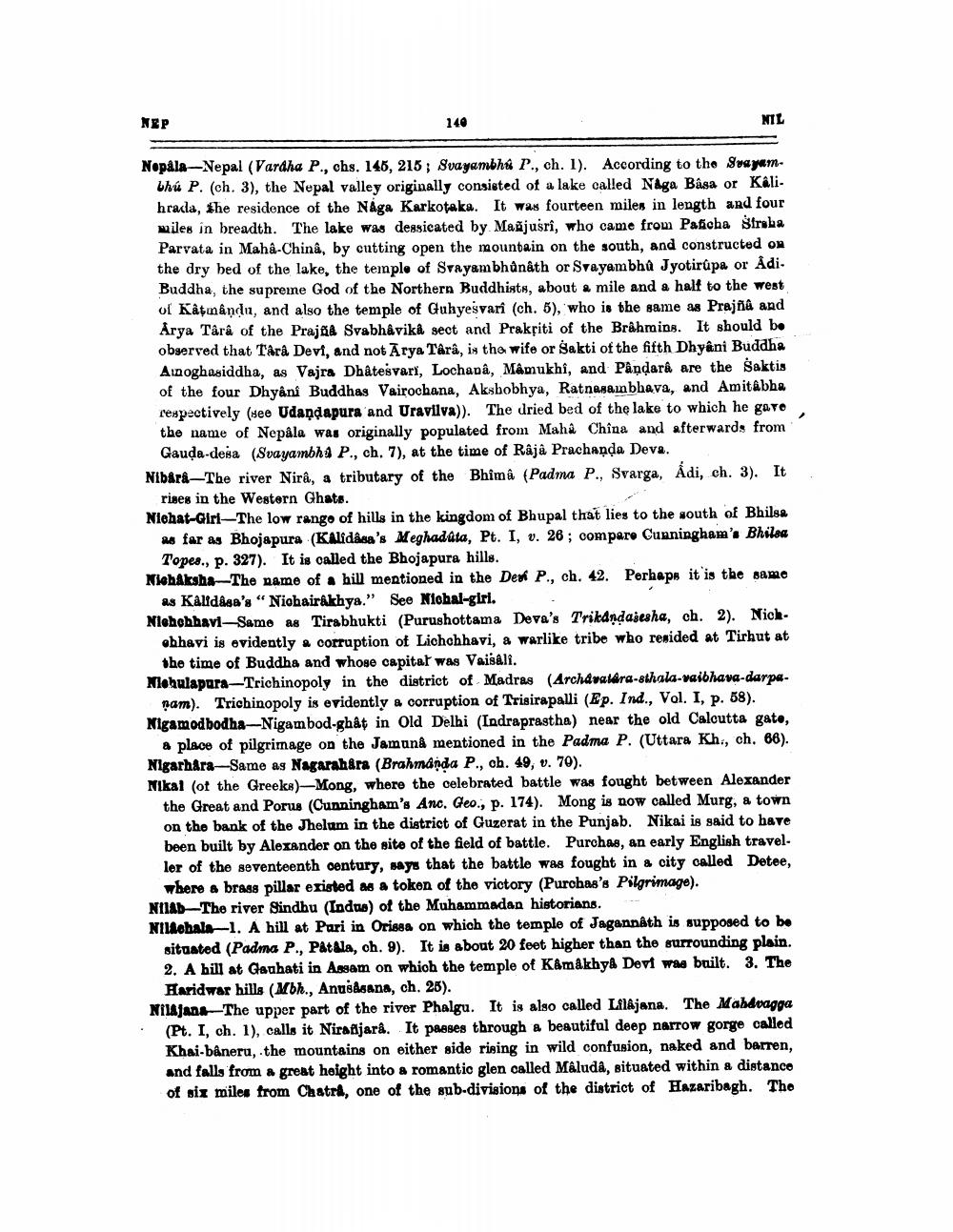________________
NEP
140
NIL
Nopala-Nepal (Vardha P., chs. 146, 215; Svayambha P., ch. 1). According to the Svayam
Whú P. (ch. 3), the Nepal valley originally consisted of a lake called Naga Basa or Kálihrada, She residence of the Naga Karkotaka. It was fourteen miles in length and four miles in breadth. The lake was dessicated by Maxjusri, who came from Pafcha Sfreka Parvata in Maha-China, by cutting open the mountain on the south, and constructed on the dry bed of the lake, the temple of Svayambhûnâth or Svayambhů Jyotirûpa or Adi. Buddha, the supreme God of the Northern Buddhists, about & mile and a half to the west of Kâţândı, and also the temple of Guhyesvari (ch. 5), who is the same as Prajña and Arya Târâ of the Prajfa Svabhävika sect and Prakriti of the Brahmins. It should be observed that Târa Devi, and not Ārya Tara, is the wife or Sakti of the fifth Dhyani Buddha Ainoghasiddha, as Vajra Dhâtesvari, Lochana, Mâmukhi, and Pandara are the Saktis of the four Dhyani Buddhas Vairochana, Akshobhya, Ratnasambhava, and Amitabha respectively (Hee Udandapura and Uravilva)). The dried bed of the lake to which he gave the name of Nepåla was originally populated from Maha China and afterwards from
Gauda-desa (Svayambhu P., ch. 7), at the time of Râjâ Prachanda Deva. Nibara—The river Nirâ, a tributary of the Bhimâ (Padma P., Svarga, Ådi, ch. 3). It
rises in the Western Ghats. Niohat-Girl-The low range of hills in the kingdom of Bhupal that lies to the south of Bhilsa
s far as Bhojapura (Kalidasa's Meghadata, Pt. I, v. 26; compare Cunningham's Bhilsa
Topes., p. 327). It is called the Bhojapura hills. Miehiksha-The name of a hill mentioned in the Deri P., ch. 42. Perhaps it is the same
aus Kalidasa's "Nichairâkhya." See Nichal-giri. Niehehhavi-Same as Tirabhukti (Purushottama Deva's Trikandasesha, ch. 2). Nich
bhavi is evidently a corruption of Lichchhavi, a warlike tribe who resided at Tirhut at
the time of Buddha and whose capitat was Vaisali. Nohulapura-Trichinopoly in the district of Madras (Archdvaldra-sthala-vaibhava-darpe
nam). Trichinopoly is evidently a corruption of Trisirapalli (Ep. Ind., Vol. I, p. 58). Nigamodbodha-Nigambod-ghåg in Old Delhi (Indraprastha) near the old Calcutta gate,
a place of pilgrimage on the Jamuna mentioned in the Padma P. (Uttara Kh, ch. 66). Nigarhára-Same as Nagarahara (Brahmanda P., ch. 49, v. 70). Nikal (of the Greeks)-Mong, where the celebrated battle was fought between Alexander
the Great and Porus (Cunningham's Anc. Geo., p. 174). Mong is now called Murg. a town on the bank of the Jhelum in the district of Guzerat in the Punjab. Nikai is said to have been built by Alexander on the site of the field of battle. Purchas, an early English travel. ler of the seventeenth century, says that the battle was fought in a city called Detee,
where a brags pillar existed as a token of the victory (Purchas's Pilgrimage). NIAD-The river Sindhu (Indus) of the Muhammadan historians. Nilachala-1. A hill at Pari in Orissa on which the temple of Jagannath is supposed to be
situated (Padma P., Patala, oh. 9). It is about 20 feet higher than the surrounding plain. 2. A bill at Gauhati in Ansam on which the temple of Kamakhya Devi was built. 3. The
Haridwar hills (Mbh., Anussana, ch. 26). NilAjan-The upper part of the river Phalgu. It is also called LilAjana. The Mahdwagga
(Pt. I, ch. 1), calls it Nirafljarâ. It passes through a beautiful deep narrow gorge called Khai-bâneru, the mountains on either side rising in wild confusion, naked and barren, and falls from a great height into a romantic glen called Mäluda, situated within a distance of six miles from Chatra, one of the sub-divisions of the district of Hazaribagh. Tho




